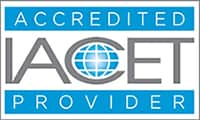
This Site Safety Training (SST) Special Elective course covers common health and safety hazards associated with welding, brazing and cutting activities at construction sites. It also explains OSHA and National Fire Protection Association (NFPA) safety regulations that aim to prevent fires and other hazards of gas and arc welding.
About the 1-Hour Welding and Cutting Course
Satisfies Training Standards for:
Site Safety Training (SST) requirements of NYC Local Law 196
Accessibility Features:
Free audio narration and Live Chat support
Approved by:
New York City Department of Buildings (DOB)
Format:
100% online course
Provides:
Instant digital certificate for 1 Special Elective hour of Site Safety Training
Designed for:
NYC construction and demolition workers who need an SST Worker card or SST Supervisor card
Who Should Take 1-Hour Welding and Cutting?
The 1-Hour Welding and Cutting course is designed for New York City construction workers seeking an SST Worker or Supervisor card.
NYC Construction workers who require this training may include:
- Construction and demolition workers
- Construction Superintendents
- Site Safety Coordinators
- Site Safety Managers
- Competent Persons
- Journeypersons and forepersons
- Other workers at jobsites that require a Site Safety Plan
For more information on SST requirements, including a list of affected workers and important training deadlines, see our guide to Local Law 196.
Course Details
The 1-Hour Welding and Cutting course explains how to recognize and avoid the safety risks of welding, cutting and brazing. You'll learn about the equipment used for gas and arc welding and important processes, regulations and administrative safety requirements to follow.
This course is 100% online and approved by the New York City Department of Buildings (DOB). It provides one hour of Site Safety Training (SST) Special Elective credit that NYC construction workers can apply toward their full SST card.
Benefits of 1-Hour Welding and Cutting
- Train at your own pace
- Guaranteed to pass
- Provides 0.1 Continuing Education Units (CEUs)
- Audio narration
- Interactive quizzes
The course takes at least one hour to complete. You must take a five-question quiz at the end of each module and pass a 20-question comprehensive final exam. The exam and all quizzes are multiple choice, and you have an unlimited number of attempts to pass. You must complete the final exam in one sitting.
You are required to score at least 80% on each quiz and at least 70% on the final exam to receive SST course credit. Once you pass each course module quiz and the final exam, you can instantly download a digital Certificate of Completion. You must complete your training within 90 days of purchase.
This course does not provide an SST card. To get your SST card, you need to finish all your required training and provide the course certificates to OSHA Education Center or another DOB-approved Site Safety Training provider.
» Learn more about DOB course requirements for SST cards
NYC Site Safety Training courses give you the opportunity to earn IACET CEUs through our parent company Certus. As an IACET Accredited Provider, Certus offers IACET CEUs for its learning events that comply with the ANSI/IACET Continuing Education and Training Standard.
Learning Objectives
The primary goal of this course is to teach New York City construction workers how to safely operate welding, cutting and brazing equipment. You will learn common hazards of welding and cutting activities and ways you can avoid safety and health risks.
Upon completing the course, you will be able to:
- Describe welding, brazing and cutting equipment and activities
- Recognize and avoid common welding and cutting hazards on construction worksites
- Identify prevention and control measures for welding and cutting safety hazards
- List administrative safety requirements, processes and regulations associated with welding, cutting and brazing activities
You can find an outline of all course modules below.
Course Outline
The course is divided into four modules related to welding and cutting safety. Each module ends with a brief quiz, and you must complete a final exam to receive your SST training credit.
Introduction
The course introduction provides a brief overview of the course, including key learning objectives and facts about Site Safety Training.
Module 1: Gas Welding
Topics covered in Module 1 include:
- Operational components of gas welding and cutting
- Safety components of gas welding and cutting
Learning objectives include:
- Describe the operational and safety components of gas welding and cutting on a construction site
- State how you can use safety controls to prevent accidents during welding and cutting work
- Explain best practices and guidelines concerning the use, storage and transportation of compressed gas cylinders
Module 2: Arc Welding
Topics covered in Module 2 include:
- Operational components of arc welding and cutting
- Safety components of arc welding and cutting
Learning objectives include:
- Describe the operational and safety components of arc welding and cutting
- Explain how safety controls can prevent accidents associated with arc welding work
Module 3: Welding Fire Prevention
Topics covered in Module 3 include:
- Roles and responsibilities of welding and cutting professionals
- The science of fire prevention
Learning objectives include:
- Explain the roles of various fire prevention professionals on a construction site
- Describe fire watch requirements and the inspection and permitting process for hot work
- State proper procedures for fire watches and fire extinguisher use
Module 4: Health Hazards of Welding and Cutting
Topics covered in Module 4 include:
- Common welding and cutting hazards
- Resources for welding and cutting safety management
Learning objectives include:
- List common health risks encountered by welders and fire protection personnel during hot work
- Identify common types of personal protective equipment (PPE) used during hot work
- List OSHA, FDNY and NFPA resources that address workers' rights to a safe workplace
The course ends with an exam that assesses the student's comprehension and understanding of all course and module objectives.
